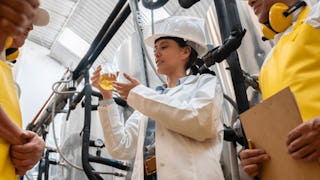In this third course of the Beer Quality Series on beer freshness, led by distinguished professor Charles Bamforth, Ph.D, you will learn about beer flavor preconceptions, expectations, and causes of flavor instability. You'll also learn about the science of flavor change and the study and process impacts of flavor stability. In addition, you will review light instability and how it can lead to skunking.

Enjoy unlimited growth with a year of Coursera Plus for $199 (regularly $399). Save now.

Beer Quality: Freshness
This course is part of Beer Quality Specialization

Instructor: Charles Bamforth
Included with
Recommended experience
What you'll learn
Discover the science behind beer freshness, how to measure and assess freshness, and how to achieve ideal freshness in beer.
Skills you'll gain
Details to know

Add to your LinkedIn profile
9 assignments
See how employees at top companies are mastering in-demand skills

Build your subject-matter expertise
- Learn new concepts from industry experts
- Gain a foundational understanding of a subject or tool
- Develop job-relevant skills with hands-on projects
- Earn a shareable career certificate

There are 4 modules in this course
In this first module, we examine the importance of flavor stability. We do this, in part by reviewing a study asking consumers if they can differentiate between fresh and stale beer and if it matters to them. We'll review how imported and domestic beer flavor is perceived by consumers, discuss the importance of delivering a consistent flavor, and understand how chemical changes affect beer flavor. We'll also go into how flavor changes are assessed.
What's included
5 videos4 readings2 assignments1 discussion prompt
In this module, we look at various chemical processes that change flavor. We'll also review how carbonyl compounds interact with proteins to change flavor and discuss strategies for minimizing flavor change.
What's included
4 videos1 reading1 assignment
In this module, we'll focus on using senses to assess flavor and typical methods of reporting flavor. We'll also review some of the tools that can be used to measure flavor instability and continue our discussion of the processes in beer production that can affect flavor.
What's included
4 videos3 readings3 assignments
In this module, we'll discuss how to prioritize when improving the shelf life of your beer and consider the susceptibility of beer to light.
What's included
2 videos2 readings3 assignments1 discussion prompt
Earn a career certificate
Add this credential to your LinkedIn profile, resume, or CV. Share it on social media and in your performance review.
Instructor

Offered by
Explore more from Chemistry
 Status: Free Trial
Status: Free TrialUniversity of California, Davis
 Status: Free Trial
Status: Free TrialUniversity of California, Davis
 Status: Free Trial
Status: Free TrialUniversity of California, Davis
 Status: Free Trial
Status: Free TrialUniversity of California, Davis
Why people choose Coursera for their career




Frequently asked questions
To access the course materials, assignments and to earn a Certificate, you will need to purchase the Certificate experience when you enroll in a course. You can try a Free Trial instead, or apply for Financial Aid. The course may offer 'Full Course, No Certificate' instead. This option lets you see all course materials, submit required assessments, and get a final grade. This also means that you will not be able to purchase a Certificate experience.
When you enroll in the course, you get access to all of the courses in the Specialization, and you earn a certificate when you complete the work. Your electronic Certificate will be added to your Accomplishments page - from there, you can print your Certificate or add it to your LinkedIn profile.
Yes. In select learning programs, you can apply for financial aid or a scholarship if you can’t afford the enrollment fee. If fin aid or scholarship is available for your learning program selection, you’ll find a link to apply on the description page.
More questions
Financial aid available,





